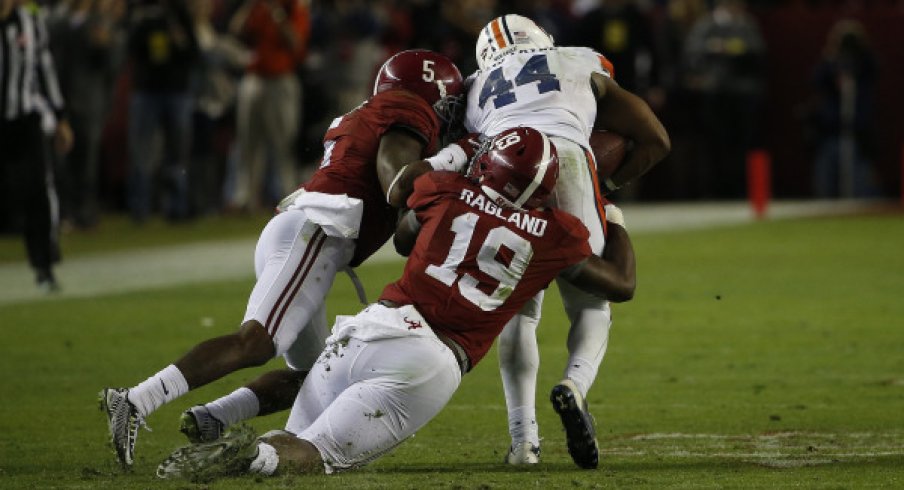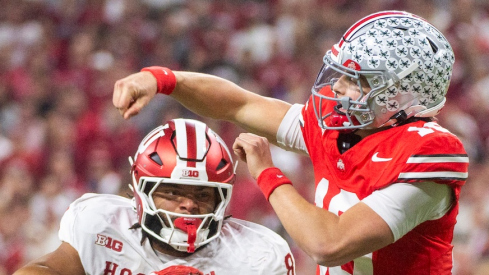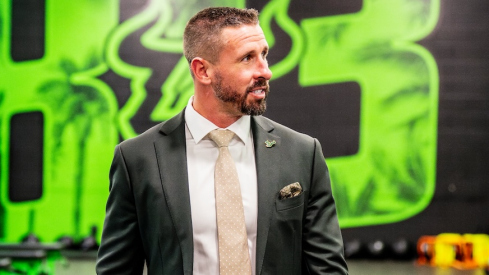The characters change, but the story remains the same.
Since taking over the Alabama program in 2007, Nick Saban has consistently put forth one of the top run defenses in the country, every single year. Not coincidentally, the Crimson Tide once again find themselves near the top of the ledger, ranking second among all FBS teams against the run, continuing a streak of seven consecutive seasons in which they finished in the top ten of that category.
Opposing running backs have found few open holes against the Tide's defense this year, who've allowed only 88 yards-per-game on the ground. No opponent has reached 100 rushing yards in a game this season, which continues the trend in Tuscaloosa since Saban's arrival, which has only seen nine players break that mark in his eight years at the helm.
Perhaps even more impressive is the fact that they've only allowed three touchdown runs this fall. That isn't just the lowest total allowed this fall, but it's also tied for the lowest total allowed by any team since 2011 when that mark was set by...Alabama.
Under Saban, the Tide has allowed 53 rushing touchdowns on the ground, by far the least of any program in the country. To put that in perspective, Ohio State is a distant number two on that list with 83 over that time.
Throughout this period of dominance, Saban and defensive coordinator Kirby Smart have had the pleasure of coaching countless high draft picks, anchoring their run defense with hole-plugging defensive linemen like Marcell Dareus and Terrence Cody and backing them up with tackling machines such as Rolando McClain and C.J. Mosley at linebacker. Then the 2014 season kicked off, there are 16 former Saban pupils from Alabama lining up as NFL defensive linemen or linebackers.
But this year is a bit different. Although there will likely be two Alabama players chosen in the top ten of this spring's NFL draft in wide receiver Amari Cooper and Strong Safety Landon Collins, linebacker Trey DePriest is the only player in the Tide's defensive front seven will likely hear his name called by an NFL team in April, and he's only currently projected to be a fifth-round pick.
By no means does this mean the Crimson Tide are lacking in talent up front though. Instead of relying on a handful of players passing the time until they can play on Sundays, Saban and Smart have turned to a rotation of big, although young, players that are all highly skilled in their own right. Seven sophomores see regular playing time on the Alabama defensive front, while only three seniors are in the same mix.
Though the group looks young on paper, it's still full of skilled players that have clearly been coached well. A pair of junior college transfers at defensive end specifically shine when the film comes on, juniors D.J. Pettway (#57) and Jarran Reed (#90).
Both showed a good mix of strength and technique, such as this example where Pettway disengages from the block of the opposing offensive tackle, using his hands well to make a play in the backfield.

Reed showed many of the same skills in Alabama's win over LSU, when he tallied 15 tackles to lead the team that night. Often using a bull rush to blow back the opposing offensive tackle, Reed was in the backfield all night.
But the Tide have a number of options up front from a personnel perspective, all of whom offer ideal size for a professional defense, much less the SEC. Although their base defense is a 3-4 scheme, Smart makes slight tweaks each week to best fit his personnel against that of the opponent, much like we see every week from NFL defensive coaches.
Keeping that in mind, Mississippi State likely offers the best proxy for what the Buckeyes will see from the Alabama defense, considering MSU coach Dan Mullen was formerly Urban Meyer's offensive coordinator at Florida. Though each team plays to the strengths of their current players, many of the same base formations and plays are the same in both schemes.
To counter the Bulldogs' spread-to-run offense, the Tide actually went with a fairly vanilla personnel package, often simply removing the "Jack" (weak-side) outside linebacker and replacing him with a "Star" defensive back.
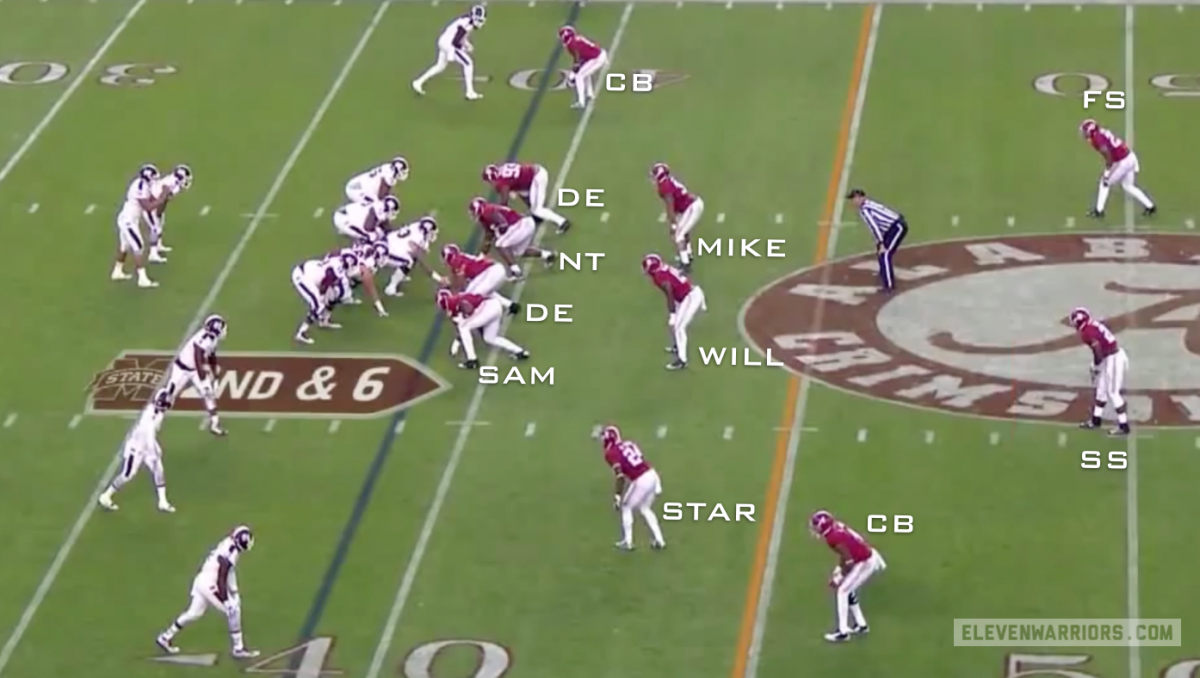
The philosophy appeared to be for the big front line to disrupt any and all blocking schemes up front and allow aggressive inside linebackers DePriest (#33) and Reggie Ragland (#19), as well as Collins (#26) to come up from his safety spot, to clean up any running plays. This has been the case all year long, as that trio are head shoulders ahead of the rest of the defense in tackles with a combined 257 takedowns between them.
For the most part, this strategy worked against Mississippi State, as the Tide held them to 138 rushing yards on 40 carries, a mark far below their season average. Bulldog running back Josh Robinson had his worst game of what turned out to be a very good season with only 37 yards to his name that afternoon.
Although that box score might look scary for the Buckeyes, the tape still show a couple plays that might give pause to Meyer and the Ohio State offense.
As mentioned earlier, DePriest is only regarded as a fifth-round draft prospect, a far drop of from what was expected from a former five-star recruit at that spot in Tuscaloosa. Although his numbers have been solid, he and Ragland have consistently struggled against lateral runs, in both the mental aspect of recognizing the play, as well as physically, with the lack of lateral quickness needed to get to a ball carrier around the edge.
Mississippi State only called for Jet motion a few times, but found success by packaging it with a read-option for quarterback Dak Prescott. In this example, the Bulldogs call the Inverted-Veer option (a staple in the OSU offense), leaving Pettway initially unblocked and left as Prescott's "read" before handing off to the motion man. Led by a kick-out block from the running back to the outside on the "Star," the ball-carrier easily gets around Pettway before turning up through a massive hole.

However DePriest was never blocked on the play and not only was caught flat-footed by the sweep action, but was too slow to recover and make a play on the ball carrier. Collins eventually made the tackle downfield, but not before giving up a ten-yard run.
To attack this lack of lateral speed, one can imagine the Buckeyes will call upon Jalin Marshall and Dontre Wilson early and often to loosen up the Crimson Tide defense inside. Jet motion that leads to either the Inverted-Veer or a simple Jet Sweep have led to a number of big plays for OSU, and with a slew of excellent blockers at the wide receiver and tight end spots, the Scarlet and Gray may well have an advantage thanks to (insert southern gasp) more speed in the alleys.
To compensate, Smart has often replaced Ragland with an additional defensive back, and dropped Collins down to an inside linebacker position. Much in the same way Tennessee took advantage of Eric Berry's unique skill set a few years ago, lining him up all over the field, Collins has the athletic ability to fit in wherever needed, be it covering a receiver downfield or stopping the run.
But though Collins as an athletic freak, he isn't a disciplined run defender and can often overrun plays, allowing cutbacks. Auburn, another spread-to-run offense, was able to take advantage of this weakness, tweaking the inverted-veer to allow Collins and others to give quarterback Nick Marshall a huge cutback lane.

Upon seeing the potential outside handoff to #20, four Crimson Tide defenders (including a blitzing Collins) all rush to the edge of the formation to make a play. But the Auburn right guard and tackle immediately head downfield to take on DePriest and other Alabama defenders, with the backside guard pulling to trap Collins instead of lead through the hole. Marshall has a wide open path and picks up nearly 30 yards on the big gain.
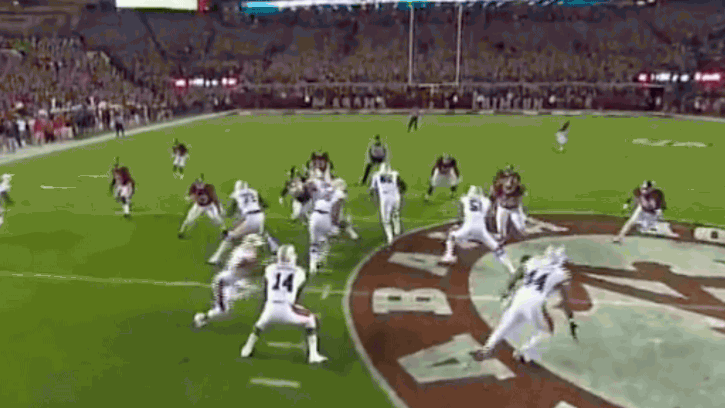
By now it's apparent that the Crimson Tide defense is vulnerable to option football. Perhaps more than ever, J.T. Barrett's presence will be missed though. Against Penn State, the only run defense that surrendered fewer yards than Alabama this year, Barrett became the engine of the OSU offense in the second half and overtime, consistently making the proper read on option plays and picking up big chunks of yards.
Though both Braxton Miller and Cardale Jones are good runners in their own right, neither has shown the same consistency in making the proper reads in the same situation. When Jones lines up under center in the Sugar Bowl, he'll have had the luxury of 15 additional practices as the number one quarterback, but with only one start under his belt, the question remains as to whether his decision-making can improve in such a short time.
The matchup between the OSU offensive line and the Alabama Defensive front should be a good one, pitting strength against strength. With neither side having a clear advantage, the Buckeyes will need players like Marshall, Wilson, and most especially Jones to show up and make plays on the ground.
Ohio State doesn't need to rack up huge numbers on the ground either, as they just need to establish enough of a threat to keep the Crimson Tide secondary honest, setting up play-action shots downfield. Though they are primarily a run-first team, Auburn showed that such a recipe can expose the back end of the Alabama defense, as they put up 44 points and over 600 yards of offense in a losing effort.
Next week, we'll take a deeper look at the Alabama pass defense, and see what the Buckeyes can learn from Auburn's offensive explosion in the Iron Bowl.
